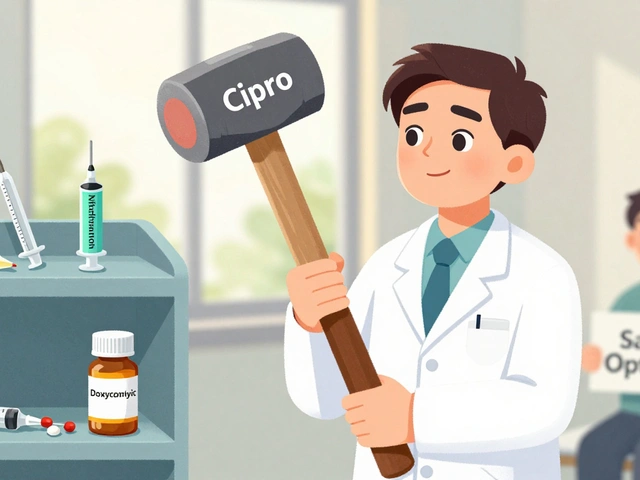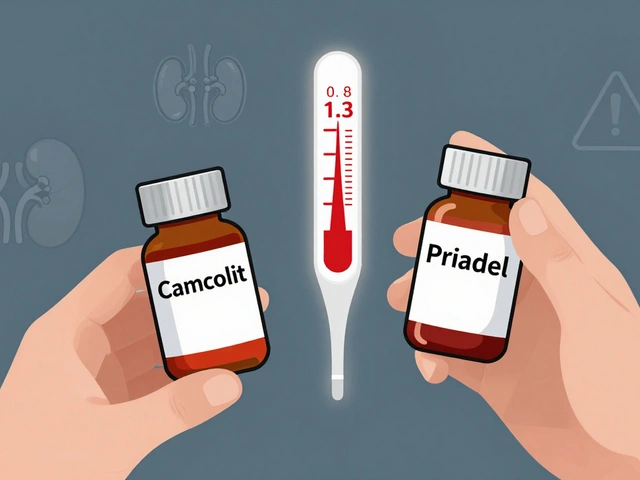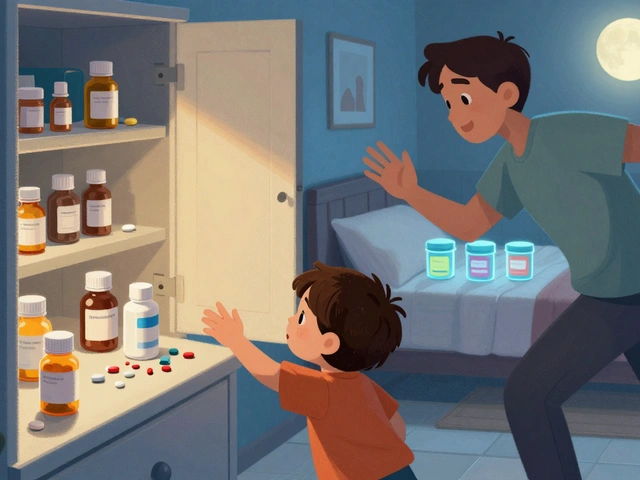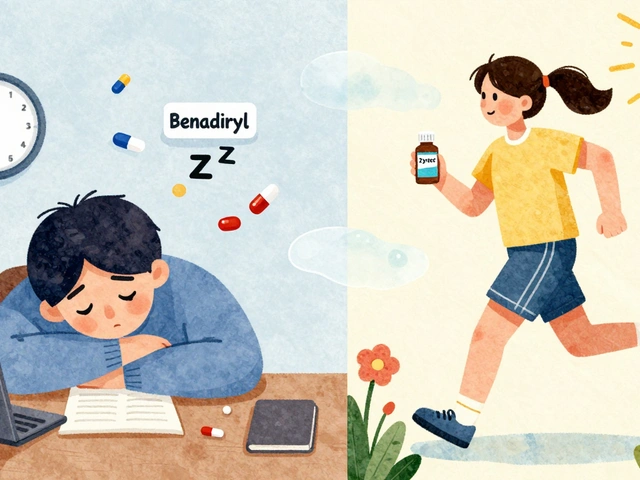
Sex shouldn’t feel like a test of pain tolerance. If your bladder aches, burns, or spasms before, during, or after sex, you can still have a good sex life-you just need a plan that respects your body. This guide gives you immediate, realistic steps to lower pain, keep intimacy on the table, and know when to get medical help. You won’t fix everything in one night, but you can make tonight better.
- bladder pain during sex can come from infection, bladder pain syndrome (IC/BPS), pelvic floor tension, hormonal changes, or irritation from products.
- Quick wins: empty your bladder, long exhale breathing, lots of lube (glycerin/fragrance-free), slow build-up, shallow penetration, warm compress after.
- Positions that reduce pressure help-side-lying spoon, partner-on-top for control, legs together to limit depth, pillows under hips or between thighs.
- If pain is new, severe, or with fever/blood, get checked. In the UK, your GP can rule out UTI/STI, consider local oestrogen, and refer for pelvic health physiotherapy.
- You’re not stuck-evidence supports pelvic floor physio, trigger mapping, and gentle behaviour tweaks to lower pain over time.
TL;DR: What’s going on and what actually helps
Jobs you probably want done:
- Understand why sex hurts when your bladder is cranky-and what’s a red flag.
- Follow a simple plan to make tonight less painful.
- Pick positions, lube, and toys that don’t flare symptoms.
- Talk to your partner without killing the mood.
- Know when to call a clinician and which treatments actually help.
Why it hurts: The bladder sits right behind the pubic bone and in front of the vagina or prostate. With arousal and thrusting, pressure can irritate a sensitive bladder lining (common in interstitial cystitis/bladder pain syndrome), or set off a tight pelvic floor. Hormonal changes (perimenopause, breastfeeding) can thin tissues and reduce natural lubrication. Irritants-like some lubes, spermicides, or latex-can sting. Infections make everything worse.
What to do fast: Pee before sex, sip water not wine, skip caffeine that evening, and set a slower pace. Use a lot more lube than you think is normal-glycerin-free, no fragrance, and avoid warming/tingling products. Breathe low and slow (6-second exhale) to relax the pelvic floor. Choose positions you can control. After, pee again, rinse with lukewarm water, and use heat for 10-15 minutes.
Red flags-don’t wait: Fever, chills, blood in urine, severe new pain on one side, pain with a new lump or swelling, or pain after pelvic injury. In those cases, pause sex and contact your GP, NHS 111, or urgent care.
Evidence snapshot (UK and international): The American Urological Association’s 2022 guidance endorses multimodal therapy for IC/BPS, including pelvic floor physical therapy, behavioural changes, and pain management. A 2023 Cochrane review supports pelvic floor physiotherapy for pelvic pain and painful intercourse. NICE guidance (updated 2024) stresses ruling out UTIs, avoiding unnecessary antibiotics, and considering topical vaginal oestrogen for GSM (genitourinary syndrome of menopause). These aren’t silver bullets-but together they lower pain for many people.
Your step-by-step playbook: before, during, after sex
Before (set up your best chance):
- Empty your bladder 10-20 minutes beforehand. Too full hurts; too empty can be irritating. Aim for comfortable, not bone-dry.
- Do 2 minutes of diaphragmatic breathing: one hand on chest, one on belly; inhale for 4, long exhale for 6-8. Think “melt the pelvic floor.”
- Heat helps: a warm pack on the lower belly for 10 minutes relaxes muscles and reduces urgency.
- Medication strategy (talk to your GP/pharmacist):
- If you have IC/BPS, low-dose amitriptyline at night can lower overall bladder sensitivity-this is common practice in UK primary care.
- NSAIDs taken 30-60 minutes before sex can blunt a flare if your stomach tolerates them.
- If you’re peri/postmenopausal with dryness, local vaginal oestrogen (prescription) improves tissue health and comfort within weeks.
- Lubricant: choose silicone-based for staying power and low friction; or a high-quality water-based gel that’s glycerin- and fragrance-free. Avoid spermicides (nonoxynol-9), warming, and menthol products-they sting sensitive bladders.
- Condoms: if latex irritates, use polyisoprene or polyurethane. Store them cool and check dates.
- Boundaries chat (30 seconds): agree on a stop word and a plan-slow start, shallow depth first, check-in after 2 minutes, no pressure to “finish.”
During (keep it comfortable):
- Warm-up counts. Arousal improves natural lubrication and tissue elasticity. Take longer with hands or mouth before penetration.
- Start shallow. Think “front porch” rather than “deep dive.” Keep legs together or use a pillow under hips to limit depth.
- Use “pause-compress-breathe”: if you feel a pang, pause movement, press a hand gently just above the pubic bone for 5-10 seconds, and exhale slowly. Resume only if the pain eases.
- Control the angle. Partner-on-top lets the receiver set depth and angle. Side-lying positions reduce direct bladder pressure. Avoid positions that fold your belly sharply (they compress the bladder).
- Reapply lube. Friction creeps up quietly; reapply every few minutes.
- Try alternatives if penetration isn’t working today: external focus, mutual masturbation, toys for outer stimulation, or cuddling with erotic talk. Pleasure doesn’t require pressure.
After (reduce flares and soreness):
- Urinate once. Don’t force it if nothing’s there, but a gentle pee can flush irritants and lower UTI risk.
- Rinse vulva/penis with lukewarm water only. Skip soap between the labia or inside the foreskin-it dries and irritates.
- Heat or cool: most prefer warmth on the lower belly; some like a cool gel pack for 10 minutes.
- Hydrate with water or a non-irritating tea (e.g., chamomile). Limit alcohol for the night; it often flares urgency.
- Note your “pain pattern”: where did it hurt (opening, deep, after), what position helped, which lube was best. Two lines in your phone is enough.
Communication tips that don’t kill the vibe:
- “Let’s start slow and keep it shallow until I say go deeper.”
- “If I say red, pause; if I say amber, slow down.”
- “If we need to switch to hands or toys, that’s still sex to me.”

Positions, products, and adjustments that reduce pressure
Position cheat sheet (pick one to try tonight):
- Side-lying spoon: bodies parallel, receiver’s knees slightly bent, small pillow between thighs. Low pressure on the bladder and easy to control depth.
- Partner-on-top (receiver on top): receiver sets pace and angle; lean forward to limit depth, lean back for different stimulation without going deeper.
- Modified missionary with a pillow under hips and legs together: reduces depth; ask your partner to keep thrusts shallow and slow.
- Straddle with wide support: sit on a firm chair edge, partner straddles facing you. You both control movement; minimal abdominal compression.
- For anal play: go slow, lots of lube, and try side-lying or on-top positions to avoid pressing the lower abdomen into the mattress.
Lube chooser (simple rules):
- Dry skin or perimenopause? Silicone-based or a thick water-based gel is kinder and longer-lasting.
- Sensitive to infections? Choose glycerin-free. Glycerin can feed yeast in some people.
- Using silicone toys? Water-based only to avoid damaging the toy.
- Sensitive bladder? Avoid fragrances, flavours, warming/tingling, and spermicides.
Products that often help (UK-friendly):
- Pelvic wand or dilators (soft, medical-grade silicone) for tender pelvic floor spots-ideally after an assessment by a pelvic health physio.
- Heat pack with a soft cover; microwaveable wheat bags are easy and effective.
- Latex-free condoms (polyisoprene) to avoid irritation.
- pH-balanced, glycerin-free lube; keep a bedside pump bottle for easy reapplication.
Decision mini-tree (where’s the pain?):
- Burning at the opening: think dryness/irritation-use more lube, avoid fragranced products, consider local oestrogen if peri/postmenopausal.
- Deep ache or urgency with thrust: reduce depth (legs together, side-lying), slow pace, try partner-on-top for control, and use a belly pillow.
- Cramp after orgasm: hydrate, use heat, try a gentle walk; discuss low-dose nightly amitriptyline or hydroxyzine with your GP if IC/BPS is diagnosed.
- Stabbing one-sided pain: pause sex and book a check-could be something other than the bladder.
| Pain trigger or pattern | What to try now | Evidence/notes |
|---|---|---|
| Pressure over lower abdomen | Side-lying or on-top; pillow under hips; shallow thrusts | Biomechanical load reduction; commonly recommended by pelvic physios |
| Dryness/burning at entry | Silicone or thick water-based, glycerin-free lube; avoid fragranced/warming products | Irritant avoidance reduces symptoms; GSM improves with local oestrogen (NICE 2024) |
| Pelvic floor spasm with penetration | Diaphragmatic breathing, reverse Kegels, slow graded exposure; consider physio | Cochrane 2023 supports pelvic floor therapy for dyspareunia/pelvic pain |
| Post-sex bladder cramp/urgency | Hydrate, heat pack 10-15 min, gentle walk, NSAID if suitable | Common clinical strategies; low risk, often helpful for IC/BPS flares |
| Recurrent UTIs after sex | Pee after sex, don’t delay peeing; discuss prophylaxis options with GP | NICE highlights non-antibiotic measures first; targeted antibiotics sometimes used |
Pelvic floor reset (quick how-to):
Reverse Kegel: as you exhale, imagine gently releasing the sit bones apart and letting the pelvic floor drop. No pushing or bearing down-just a soft release. Do 5 slow breaths before and any time during sex when you feel clenchy.
When to get medical help, UK treatment options, and your FAQ
When to see someone:
- New, severe, or worsening pain-especially if it’s deep or one-sided.
- Fever, blood in urine, foul-smelling urine, or pain with peeing-could be UTI/STI.
- Persistent pain despite the adjustments here.
- Vaginal dryness, tearing, or painful entry in peri/postmenopause.
What your GP/NHS team might do (2025 UK context):
- Rule out infection: urine dip/culture; treat confirmed UTIs intelligently-NICE discourages repeated antibiotics without culture evidence.
- Screen for STIs if indicated.
- Assess pelvic floor: if muscles are overactive, refer to pelvic health physiotherapy (NHS or private). Expect education, manual therapy, relaxation/breathing, and a graded home plan.
- Discuss bladder pain syndrome (IC/BPS) if tests are clear but symptoms persist: multimodal care-behavioural changes, pain relief, pelvic physio first line (per AUA guidance).
- Offer local vaginal oestrogen for GSM; it’s safe for most, with minimal systemic absorption.
- Consider medications for chronic bladder pain: low-dose amitriptyline, hydroxyzine, or others based on your profile. Mirabegron/antimuscarinics help urgency but not always pain.
- Refer on if needed: urology, gynaecology, pain clinic, or psychosexual therapy.
How to talk to a clinician so you get traction:
- Bring a 1-week symptom snapshot: pain score before/during/after sex, triggers, what helped.
- Use clear words: “It hurts at the entrance” vs “It aches deep under the pubic bone.”
- Ask directly: “Could my pelvic floor be overactive?” “Would local oestrogen help?” “Can I be referred to pelvic health physio?”
Mini-FAQ
Is it safe to have sex when my bladder hurts? If it’s a known chronic condition and you don’t have red flags (fever, blood, severe new pain), yes-provided you keep it comfortable. If you suspect a UTI or have systemic symptoms, pause and get checked.
Will peeing after sex stop my flares? It helps reduce UTI risk and clears irritants, but it won’t fix bladder pain syndrome on its own. Combine it with gentler positions, more lube, and pelvic floor relaxation.
Do cranberry or D‑mannose help? Cranberry has mixed evidence; D‑mannose shows promise in small studies for reducing recurrent UTIs, but it’s not a cure and evidence is still developing. If you try them, track your results and run it by your GP, especially if you take other meds.
What about phenazopyridine (urinary analgesic)? It’s not commonly used over the counter in the UK. Speak with a pharmacist or GP about safe pain relief options for your situation.
Can pelvic floor exercises make it worse? Traditional Kegels can aggravate an already tight pelvic floor. Focus on relaxation (reverse Kegels, long exhales) unless a physio has assessed you and given a tailored plan.
Does alcohol actually make bladder pain worse? For many, yes-it’s a diuretic and can irritate the bladder. If sex is planned, consider saving drinks for another night.
Troubleshooting for different scenarios
- Tonight’s pain spikes halfway through: pause, switch to hands/oral, apply a warm pack to the belly for 5 minutes, and revisit penetration another day.
- You want sex but fear the flare: plan a “comfort night”-no penetration, just slow external touch and cuddling. Pleasure builds confidence, which lowers tension.
- Partner worries they’re hurting you: give them the plan-“shallow first, I guide depth, check-in at 2 minutes.” When they know the rules, everyone relaxes.
- Dryness despite lube: talk to your GP about local oestrogen if peri/postmenopausal; consider a thicker gel or silicone lube and take longer to warm up.
- Good day/bad day swings: pick a traffic-light system-green day (penetration okay), amber (gentle external), red (cuddle + heat). Tell your partner which colour as you start.
Short checklist (save this):
- Empty bladder + warm pack 10 minutes before.
- Long exhale breathing (5 cycles) to soften pelvic floor.
- Glycerin-free, non-fragranced lube within reach-and use lots.
- Start with side-lying or receiver-on-top, shallow depth.
- Pause-compress-breathe if a pang hits; switch activities without apology.
- Pee once after; rinse with water; heat or cool pack 10 minutes.
- Jot 2 lines: what helped, what hurt.
You deserve intimacy that doesn’t cost you a flare. With a few tweaks, solid communication, and the right clinical support, pain stops running the show-and closeness gets to be, well, close.






7 Comments
When you look at the interplay between bladder discomfort and intimacy, you begin to see a micro‑cosm of the human condition – a dance of vulnerability and resilience.
We are, after all, bodies that crave connection while simultaneously guarding against pain.
It’s not just about the physiological triggers; the mind interprets every twinge as a potential threat, amplifying the very sensation it wishes to avoid.
Thus, the first step is a mindful acknowledgment that the pain is a messenger, not a tyrant.
By emptying the bladder beforehand you remove the obvious pressure, creating a literal and figurative space for pleasure to emerge.
Long exhalations act like a reset button for the autonomic nervous system, coaxing the pelvic floor muscles into a state of release rather than contraction.
Choosing a glycerin‑free, fragrance‑free lube is akin to laying down a smooth runway for intimacy, preventing the friction that would otherwise ignite irritation.
Side‑lying and partner‑on‑top positions are not merely suggestions; they embody a philosophy of control, allowing the receiver to dictate depth and angle, thereby minimizing undesirable pressure on the bladder wall.
Even the simple act of applying a warm compress post‑play can be seen as an act of self‑compassion, soothing the inflamed tissues and signaling to the nervous system that safety has returned.
If red flags such as fever, hematuria, or severe unilateral pain appear, the body is demanding a higher level of medical attention – a reminder that we must sometimes defer to professional expertise.
In the UK context, the availability of pelvic health physiotherapy offers a pathway to retrain the pelvic floor, teaching patients how to negotiate tension and restore functional harmony.
Low‑dose amitriptyline, when prescribed, works not only as an analgesic but also as a modulator of hypersensitivity, reflecting the biopsychosocial model of chronic pain management.
Local vaginal estrogen, particularly for peri‑ or post‑menopausal individuals, addresses the estrogen‑deficiency component of tissue fragility, underscoring the importance of hormonal balance in sexual comfort.
It is essential to view each recommendation not as a checklist, but as an integral part of a personalized script that respects your unique anatomy and lived experience.
Remember, intimacy is a collaborative performance; communication, preparation, and adaptation are the three pillars that transform discomfort into shared pleasure.
One should, with due decorum, merely ensure the bladder is voided prior to coitus, thereby mitigating undue pressure.
Indeed, as you noted, a pre‑emptive void can dramatically reduce intravesical strain; additionally, the incorporation of diaphragmatic breathing, which promotes diaphragmatic descent, further attenuates pelvic floor hypertonicity, and, not least, the selection of silicone‑based lubes ensures sustained slipperiness, thereby preventing micro‑abrasions, and all of these measures synergistically foster a more comfortable sexual experience.
Totally vibe with that, bro 😎 just keep it chill and comfy.
Oh dear, the drama of a painful night can feel like a thunderstorm in the bedroom! 🌩️ Yet, fear not, for we have the arsenal of cushions, lube, and clever positioning to tame that tempest.
Picture this: you, your partner, a soft pillow nestle under the hips, and a gentle wave of silicone lube gliding like calm water.
When the urge to plunge deep arises, remember the spooning position – it cradles the bladder like a lover’s embrace.
And should you sense a flare, pause, press, breathe – the trio of pause‑compress‑breathe is your secret weapon.
The key is communication; a simple “let’s keep it shallow” can turn tension into trust, and trust into bliss.
It is commendable that you have identified such practical strategies; however, let us expand upon them with a structured, evidence‑based perspective.
First, the pre‑coital void should be timed precisely – ideally within ten minutes of initiation – to avoid both over‑distension and the irritative effect of an empty bladder, as shown in recent urological studies.
Second, diaphragmatic breathing should be practiced in a paced manner: inhale for four seconds, hold for one, exhale for six to eight seconds, repeating this cycle for at least two minutes before intimacy begins; this technique has been demonstrated to reduce sympathetic tone and lower pelvic floor hyperactivity.
Third, the selection of a silicone‑based lubricant is advantageous not only for its viscosity but also for its inert chemical profile, which minimizes the risk of allergenic reactions and maintains lubrication over extended periods of activity.
Fourth, when employing side‑lying or partner‑on‑top positions, consider the addition of a lumbar support pillow to further distribute intra‑abdominal pressure away from the bladder dome, thereby reducing nociceptive input.
Fifth, the pause‑compress‑breathe maneuver you described aligns with the concept of “pelvic floor gating,” a method wherein gentle manual pressure over the pubic symphysis coupled with slow exhalation facilitates the reflexive relaxation of the levator ani muscles.
Sixth, post‑coital care should incorporate a warm compress applied for ten to fifteen minutes, followed by a gentle sip of water infused with chamomile; both actions have been shown to promote smooth muscle relaxation and mitigate post‑coital urgency.
Finally, documentation of symptom patterns – pain intensity, location, duration, and triggering factors – is essential for longitudinal tracking and facilitates meaningful dialogue with healthcare providers, ensuring that any escalation, such as the presence of hematuria or systemic symptoms, is promptly addressed.
By integrating these refined measures into your existing plan, you create a comprehensive, multimodal approach that not only reduces immediate discomfort but also contributes to long‑term pelvic health.
Great job expanding the plan!!! Keep tracking your symptoms, stay positive, and enjoy the journey 😊.